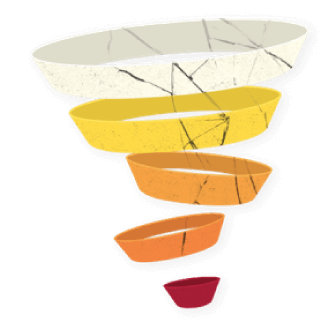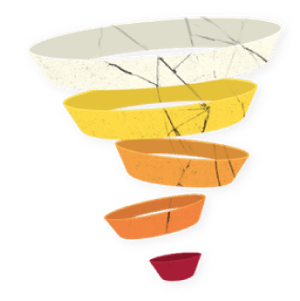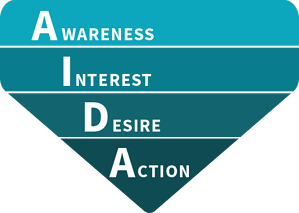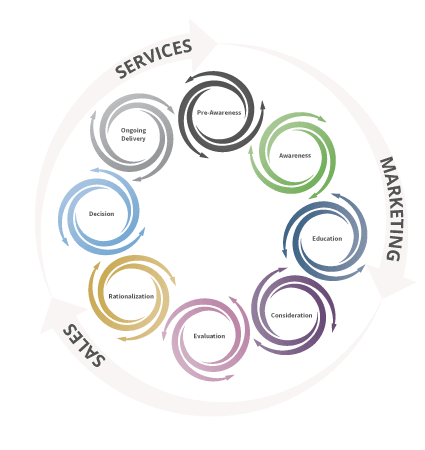
The Sales Funnel Is Dead: What’s Next?
The New Buyer Journey Demands A New Model
 In the last decade, the Internet and social media have rewritten almost everything you knew about sales and marketing.
In the last decade, the Internet and social media have rewritten almost everything you knew about sales and marketing.
Your sales team no longer cold calls prospects. Your marketing team is focused on inbound tactics, which continue to evolve. You’ve heard about the death of a hundred different sales and marketing techniques.
So why are you still using the outdated concept of a sales funnel?
Sales teams have been noticing it’s more difficult to achieve their quotas. Buyers don’t act in predictable ways anymore. Even using the latest techniques, your salespeople are still struggling.
It’s time for a paradigm shift.
It’s Time To Retire The Sales Funnel
In the late 19th century, the idea that you needed a team to sell products and services to people was still new. Sales pioneers needed to explain why people bought some products and services but not others. Then they needed tools to help them guide those buying processes.
One of those tools for understanding buyer behavior was the sales funnel. Prospective customers entered at the top of the “funnel.” They then moved through additional stages, before emerging as a newly minted customer.
The funnel shape also demonstrated that not every lead would move through all stages. Of 100 leads, only some would advance all the way to become customers.
For decades, this shape fit the buyer’s journey through the sales process. It’s sometimes called the AIDA model. The buyer moves through four stages:
 Awareness: People have to know a product or service exists before they can buy it.
Awareness: People have to know a product or service exists before they can buy it.- Interest: Salespeople pique curiosity, and potential customers learn more about the product or service.
- Desire: Having learned about the product or service, would-be customers decide they need it or want it. Salespeople play a key role here too.
- Action: The customer follows through on their desire and makes a purchase.
The AIDA model gives your sales reps a large role to play in the customer’s journey from prospect to customer. They’re responsible for creating awareness, interest and desire for the passive customer.
To achieve this, salespeople could use a number of techniques and sales tactics. Most of these were aimed at convincing the customer they wanted or needed to have what you were selling.
The Customer Takes The Reins
The AIDA model gives your salespeople a large amount of control. They’re the ones deciding on techniques and tactics to use with a customer. The sales funnel assumes the only reason people haven’t bought from you is because they haven’t heard about you. In this model, sales reps tell customers what they want.
You might have already guessed today’s customer doesn’t want to be told what they want. The rise of the Internet has shifted the balance, and your customers are more in control than ever before.
Why The Buyer’s Journey Has Changed
It’s hard to pinpoint a single factor in the shift in customer attitudes, but the fact is things have changed. Some of the reasons include:
- The Internet and a change in access to information
- Increasing awareness of marketing techniques
- Customer demand for choice and customization
You can look at the numbers to see this in action. Today, customers are skeptical of brands. They’re able to identify marketing techniques, and they prefer to verify your claims. With the Internet at their fingertips, they can most definitely fact-check your statistics.
Customers are also more independent when it comes to learning about new products and services. Buyers are often nearly 60% of the way through their journey before they contact a salesperson.
When they do reach out to your team, today’s buyer might already have a good idea of what they’re looking for. Your job isn’t to tell them why they want what you offer, but to help them find a solution to the challenges they face.
The Sales Funnel No Longer Fits
You might think the empowered buyer would create a more streamlined path to sales. They do the research, then send an email when they’re ready to buy. In doing so, they’ve cut out most of the old-fashioned sales funnel.
The shape of the buyer journey has changed, although the result is anything but streamlined.
In fact, the buyer’s journey has become even more complex. B2B sales, for example, involve an average of seven different decision-makers. That’s seven people you have to convince with your solution.
Buyers also enter and exit the cycle seemingly at will. Someone may contact you with some questions during their initial research. Then you won’t hear from them for months, and one day, they show up in your inbox, ready to buy.
Other leads will contact you while they’re knee-deep in negotiations with a competitor.
The streamlined funnel looks quaint in this storm of leads popping in and out of the journey at various stages.
What sales needs now is a new way of visualizing the journey from lead to satisfied customer. By ditching the outdated idea of the funnel, you can give your sales team a model that represents what they’re seeing.
Out With The Old, In With The New
What should this new model look like? The new buyer’s journey is a bit chaotic. It’s also more accurately envisioned as a cycle, rather than the linear process of the funnel.
In the old model, customers entered at the top of the funnel and exited at the bottom. Once they’d made a purchase, you were no longer concerned with them.
This isn’t true in an age when an upset customer can call you out on Twitter as easily as a pleased customer can give you a shout-out. Once they’ve made a purchase, customers are with you, for better or worse.
You need to attend to this, because you want to be at the top of the list when customers need to buy again. It takes less time and money to keep an existing customer happy than it does to get a new one. Furthermore, existing customers usually increase their purchases over time, increasing their value.
Given this chaotic, cyclical nature, the modern buyer’s journey is best envisioned by a cyclone. The Cyclonic Buyer Journey™ captures the whirlwind element of customers entering and exiting the journey at any point.
It also expands the old four-stage model to a more encompassing eight-stage one. This more complex journey represents what your customers go through when they decide to buy.
The 8 Stages Of The New Buyer’s Journey
While increased access to information should streamline the buyer’s journey, it’s made things more complex. With so much information floating around out there, your leads may not know where to look for guidance.
This is one of the major reasons the buyer’s journey has expanded from four to eight stages. Another reason for this expansion is because sales leaders now think of a buying cycle, not a buying process.
The Cyclonic Buyer Journey model’s eight stages reflect this reality. It also admits that customers can move backward and forward through these stages at any time.
- Pre-Awareness: The customer has a pain point, but they aren’t aware solutions exist. Pain can trigger them to move to the Awareness Stage.
- Awareness: At this stage, people seek solutions by conducting online research or asking colleagues.
- Education: After Awareness, customers continue to educate themselves about different solutions. This stage typically involves more intensive research as the customer dives deep.
- Consideration: The customer narrows their options to a few potential solutions.
- Evaluation: The customer dives even deeper, comparing, testing and contrasting their potential solutions.
- Rationalization: The customer moves from considering and evaluating to concrete terms. They want delivery deadlines and payment terms. They’ve already made a decision, but they need a rationalization for it.
- Decision: Contract details are hammered out and paperwork is signed.
- Ongoing Delivery: The customer made the purchase, but now they’re expecting you to meet their needs on an ongoing basis.
It’s easy to see how customers can move back and forth between stages. If a customer gets to the Evaluation Stage and doesn’t like any of the options, they might move back to Consideration, while a prospect in the Education Stage might skip forward to Rationalization.
Why You Need To Rethink The Buyer Journey
You may be thinking to yourself, so what? The sales funnel worked well for so long. Even if it’s outmoded now, is there a point in replacing it?
The value of the sales funnel was always that it gave your sales team direction. In fact, that’s part of the reason it’s hung on so long, despite declining in effectiveness for years.
Some people are still using this model because they don’t know what else to do. Even if it no longer truly works, it gives your salespeople a sense of direction.
This can be comforting, especially in the face of the Cyclonic Buyer Journey. The idea of a funnel gives a buyer’s behavior some structure. It makes it seem less chaotic, and it lets your salespeople plan their next steps.
The problem is that those steps are tailored to an outmoded buyer journey. They don’t work anymore. Your salespeople aren’t responding to the customer’s needs.
The New Model On The Block
It’s time to give your sales team something new and more effective. The Cyclonic Buyer Journey method can help them identify which stage a potential buyer is in. From there, they can decide what actions to take.
This updated approach replaces the older actions and techniques recommended by the funnel. Instead, your team can get recommendations for actions proven to work with buyers at every stage of the modern buying cycle.
Armed with new knowledge and a structured way to view the buyer journey, your salespeople can approach sales with more confidence.
The results of adopting this updated method can’t be understated. Switching to a collaborative sales methodology has been known to boost sales success. More reps will be able to achieve and exceed their quotas, which translates into higher revenue.
The Cyclonic Buyer Journey method allows your salespeople to see the entire buying process, including what happens after a sale. These steps are crucial for cementing a relationship with the customer. Companies that adopt a relationship-based sales approach are more successful than those that don’t.
Step Into The Modern Era
It’s high time to leave behind antiquated ideas of how people buy things. The sales funnel predates the Model T and the Sears catalog, both of which consumers have long abandoned. It’s time to send it to the scrap heap and adjust to how your 21st-century customers buy.

CEO and Chief Revenue Scientist
Mike Lieberman, CEO and Chief Revenue Scientist
Eliminate Hit-or-Miss Marketing Moves
Get advice, tips, tools and guidance to generate more leads for your company in this weekly email newsletter.



Eliminate Hit-or-Miss Marketing Moves
Get advice, tips, tools and guidance to generate more leads for your company in this weekly email newsletter.













